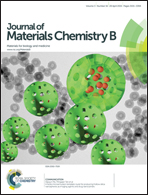A highly bioactive and biodegradable poly(glycerol sebacate)–silica glass hybrid elastomer with tailored mechanical properties for bone tissue regeneration†
Abstract
Biodegradable poly(glycerol sebacate) (PGS) elastomers have received much attention as promising materials for potential applications in soft tissue repair and regeneration, due to their biomimetic viscoelastic properties. However, the low strength and the absence of bioactivity have limited their potential applications in hard (bone, tooth, tendon and ligament) tissue regeneration. Here, we introduced the molecular-level silica bioactive glass into the matrix of polymer elastomers to prepare bioactive hybrid elastomers (PGSSC) for bone tissue regeneration applications. We have shown here that our PGSSC provide some advantages over conventional bioactive materials and elastomers due to their controlled biomineralization (apatite-forming bioactivity), tunable elastic properties and biodegradation, and enhanced osteoblast proliferation. The tensile strength and the initial modulus of PGSSC hybrid elastomers ranged from 1 to 5 MPa and 2 to 32 MPa respectively by controlling silica phase contents, which are several times higher than pure PGS elastomers. PGSSC elastomers also showed enhanced hydrophilicity with contact angle ranging from 75 to 25 degree. The biological apatite was formed on the surfaces of PGSSC when soaked in simulated body fluid (SBF) for 1 day. The osteoblast (MC3T3) demonstrated significantly enhanced proliferation on PGSSC compared with PGS. The development of bioactive PGSSC hybrid elastomers may offer a new choice for bone tissue repair and regeneration.


 Please wait while we load your content...
Please wait while we load your content...